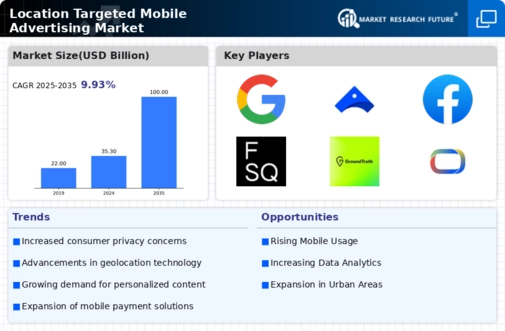Rising Smartphone Penetration
The proliferation of smartphones has been a pivotal driver for the Location Targeted Mobile Advertising Market. As of 2025, it is estimated that over 80 percent of the population in developed regions owns a smartphone, facilitating the adoption of location-based services. This trend indicates that advertisers can reach a larger audience through targeted mobile ads, enhancing engagement and conversion rates. The ability to access real-time location data allows businesses to tailor their marketing strategies effectively, ensuring that advertisements resonate with consumers in specific geographical areas. Consequently, the Location Targeted Mobile Advertising Market is likely to experience substantial growth as more consumers utilize mobile devices for daily activities, including shopping and social networking.
Expansion of E-commerce Platforms
The rapid growth of e-commerce platforms is significantly impacting the Location Targeted Mobile Advertising Market. As more consumers turn to online shopping, businesses are increasingly utilizing location-based advertising to drive foot traffic to physical stores. In 2025, it is projected that e-commerce sales will account for a substantial portion of total retail sales, prompting retailers to adopt location-targeted strategies to attract customers. By leveraging location data, businesses can create compelling offers that encourage consumers to visit their stores, thereby bridging the gap between online and offline shopping experiences. This trend indicates a promising future for the Location Targeted Mobile Advertising Market as e-commerce continues to evolve.
Increased Focus on Local Businesses
The growing emphasis on supporting local businesses is a notable driver for the Location Targeted Mobile Advertising Market. Consumers are increasingly inclined to shop locally, which presents an opportunity for businesses to utilize location-targeted advertising to reach potential customers in their vicinity. This trend is reflected in the rise of community-focused marketing campaigns that highlight local products and services. As local businesses seek to enhance their visibility, the demand for location-based advertising solutions is likely to increase. This shift suggests that the Location Targeted Mobile Advertising Market will benefit from the heightened interest in local commerce, fostering a more personalized shopping experience for consumers.
Advancements in Location Technologies
Technological advancements in GPS and location-based services are significantly influencing the Location Targeted Mobile Advertising Market. Enhanced accuracy in location tracking enables advertisers to deliver more relevant and timely ads to consumers. For instance, the integration of technologies such as Bluetooth beacons and Wi-Fi positioning systems allows for precise targeting within physical retail environments. This capability not only improves the effectiveness of advertising campaigns but also provides valuable insights into consumer behavior. As these technologies continue to evolve, the Location Targeted Mobile Advertising Market is expected to expand, with businesses increasingly leveraging sophisticated location data to optimize their marketing efforts.
Growing Demand for Personalized Marketing
The increasing consumer expectation for personalized experiences is driving the Location Targeted Mobile Advertising Market. Consumers are more likely to engage with advertisements that reflect their preferences and behaviors. As a result, businesses are investing in data analytics to understand consumer patterns better and deliver tailored content. Reports indicate that personalized ads can lead to a 20 percent increase in conversion rates compared to generic advertisements. This trend suggests that the Location Targeted Mobile Advertising Market will continue to thrive as companies prioritize personalized marketing strategies to enhance customer engagement and loyalty.

















Leave a Comment